How to quickly choose a digital oscilloscope
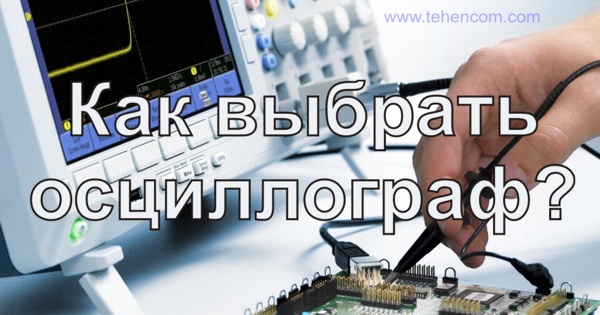
Brief introduction
The market for digital oscilloscopes offers many series from various manufacturers, so choosing even such an instrument known to every engineer becomes a daunting task. At the same time, a thorough comparison of the characteristics and capabilities of models from different manufacturers may not answer the question: which oscilloscope is best for my needs?
In this article, relying on our experience, we will talk about simple criteria for choosing the optimal oscilloscope, consider typical applications, and offer oscilloscope models for each typical task, choosing which you can work efficiently and save your money, time and nerves.
Oscilloscope selection criteria
To begin with, it is desirable to decide on the main questions:
- in what price range we will choose: up to $1 000, $1 000 – $4 000, more than $4 000?
- which maximum frequency measured signals: up to 100 MHz, 100 – 500 MHz, 1 GHz and more?
- how many main analog channels: 2, 4, 6 or 8?
- whether it is necessary to detect impulse signals and rarely occurring events: glitches, interference?
- do you work with serial digital interfaces (USB, I2C, SPI, UART, CAN, LIN, etc.)?
- do you work with parallel digital buses (8, 16, 32 or 64 signals)?
- is it necessary to measure the frequency components of signals (harmonics, etc.)?
Let's consider each of them in more detail, as it is important for a correct and informed choice.
Issue price
When choosing an oscilloscope, the first question that you may be interested in is the cost of the instrument. The cost of digital oscilloscopes depends on many parameters, such as: bandwidth, sample rate, number of channels, memory size, built-in protocol analysis, etc.
If, when choosing an oscilloscope, you are guided only by its price, then you may not be satisfied with its other parameters. On the contrary, think about the value of the device, based on its characteristics and capabilities. Good instrument allows you to quickly and efficiently perform work, and this saves time, nerves and money.
In the range up to $1 000, economy models with a bandwidth of 25 – 70 MHz are mainly offered, as well as various USB oscilloscopes and Bluetooth set-top boxes, which use the screen of a computer, tablet or smartphone to display the signal. But there are also full-fledged "classic" devices. If you want to buy the best oscilloscope under $1 000, be sure to check out the economy series Tektronix TBS1000B.
In the range from $1 000 to $4 000, there are most interesting models with a bandwidth of 100 – 200 MHz and advanced analysis of analog and digital signals. Typical in this price range: Benchtop mixed signal oscilloscopes MSO2000 and DPO2000 and oscilloscopes that only have analog channels TBS2000B. And the cheapest series in this price range are USB oscilloscopes PicoScope 3000D.
In the $4 000+ range, oscilloscopes are available for serious development and complex repairs. These oscilloscopes typically have a bandwidth of 300 MHz or more, digital signal analysis capability (typically 16 channels), a separate spectrum analyzer input for comprehensive frequency domain analysis, and many additional options to make your job easier. Typical representatives of this range: classic series MDO3 and USB series PicoScope 6000E.
Series of oscilloscopes, which belong to expensive, professional solutions, start with a line MDO4000C starting at $8 000, includes three new series (MSO4, MSO5, MSO6) and end with the top series DPO/MSO70000 with maximum performance (bandwidth up to 33 GHz) and price from $40 000. Thanks to their unique features, these oscilloscopes will fit perfectly into the measurement laboratory working on large projects.
Oscilloscope bandwidth
The bandwidth of the oscilloscope should be slightly higher than the maximum frequency of the analog signals to be measured. For example, if the maximum frequency of analog signals is 70 MHz, then it is better to choose an oscilloscope model with a bandwidth of 100 MHz. To work correctly with digital (rectangular) signals, it is necessary that the bandwidth margin is much higher. If you want to view a 70 MHz clock (square) waveform, then a 100 MHz oscilloscope will not be enough. For comfortable work with digital signals, it is better to choose an oscilloscope with a logic analyzer option. Here is an example of such an option: 16 channel logic analyzer
Of course, you always want the oscilloscope to have the widest possible bandwidth, but as the bandwidth increases, the price of the device immediately increases significantly. A good oscilloscope with a bandwidth of 200 MHz costs about $2 000, and a good oscilloscope with a bandwidth of 1 GHz is about $10 000. So a healthy compromise is important in this matter.
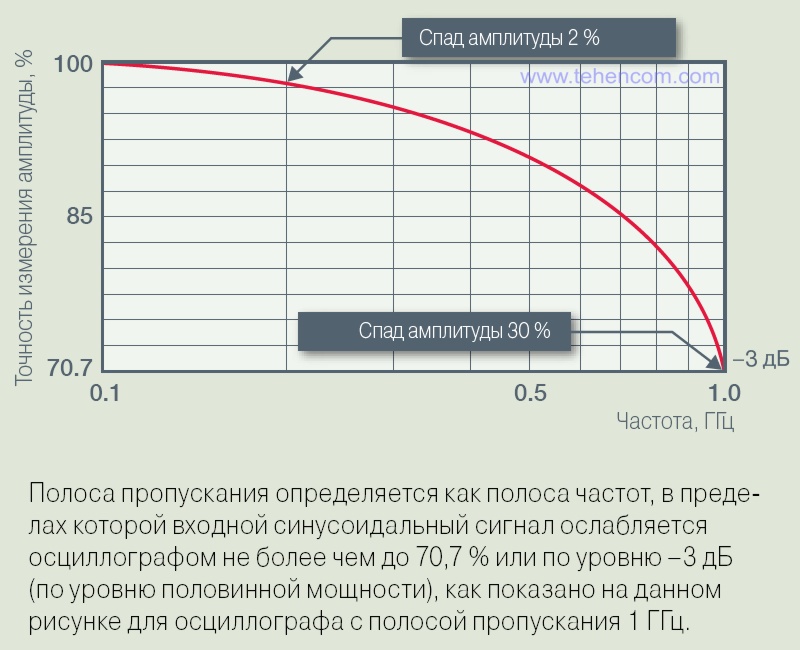
By bandwidth, digital oscilloscopes can be roughly divided into three categories: entry-level (100 MHz and below), intermediate level (200 MHz and 350 MHz), and professional level (500 MHz and above). Due to the constant development of technology, the boundary between these levels is gradually shifting. Very soon, models with a bandwidth of 200 MHz will move into the entry-level category.
It must be understood that, having the same band, models of different series can differ greatly in terms of their capabilities and cost. This is clearly seen in the example of the new review of 18 oscilloscopes 500 MHz, which compares the key features of each series and the prices of all models.
Number of main channels
Modern oscilloscopes come with 2 or 4 main channels. Economy models contain 2 channels, good series 2 or 4 channels, and expensive professional oscilloscopes always contain 4 or more channels. On average, the price of a 4-channel model is 1.5 times higher than a similar 2-channel model, and the price of a 6-channel model (for example, MSO46) is 20% higher than a similar 4-channel (for example MSO44). So in this matter, the choice depends on the planned amount and scope of the oscilloscope. There are tasks where the 2-channel model will not work, for example, working with three-phase power networks or multi-channel audio systems.
Please note that some oscilloscope series allow you to upgrade (increase) the bandwidth later with the purchase of a digital dongle. In this case, the device itself does not need to be sent anywhere: the unlock code is entered in the oscilloscope menu. But adding two additional channels to a 2-channel oscilloscope is not so easy. That is, if you plan to upgrade your oscilloscope in the future, it is better to buy a 4-channel model, and later expand the bandwidth using an activation code.
It is also worth mentioning separately the new series of multi-channel oscilloscopes Tektronix MSO5. This series includes models with four, six and eight channels, each of which can serve as an analog channel or as 8 digital channels. The transition from analog channels to digital is performed by a simple replacement of the probe, right during operation.
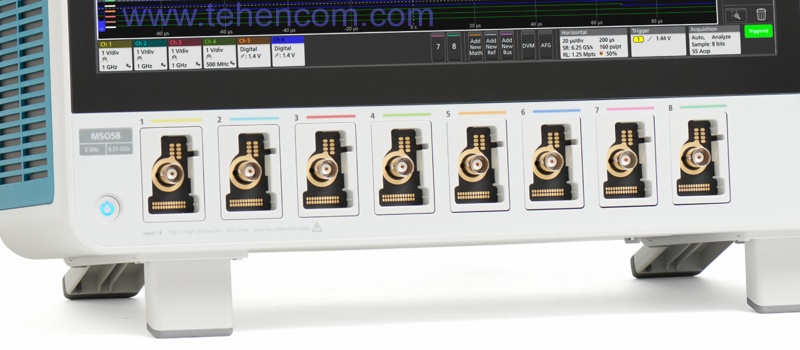
Of the eight-channel models that appeared after 2020, the PicoScope 6000E series from Pico Technology is very interesting and promising. This series includes oscilloscopes with 500 MHz bandwidth and sampling rates up to 5 GS/s. The bit depth of the built-in ADCs varies from 8 to 12 bits.
Detection of infrequent events
A typical low-cost oscilloscope does a good job with periodic signals (which are always present), but in the development or repair of electronic equipment, it is very common to find an infrequent event: a clock signal failure, a glitch, or an occasional power surge. And this is not an easy task for an oscilloscope.
Descriptions of oscilloscopes that work well with rare and short events (less than 1 ms) should include the characteristic: waveform capture rate. It is desirable that this value be at least 5 000 waveforms per second. This means that the oscilloscope actually measures and analyzes the signal 5 000 times per second, and if an abnormal event occurs at least once, it will be detected and displayed.
Also, the digital phosphor (afterglow) function is very helpful in detecting short anomalies. This function displays infrequent events in a different color and is very visible on the waveform. Read more in a separate article: description of DPO technology.
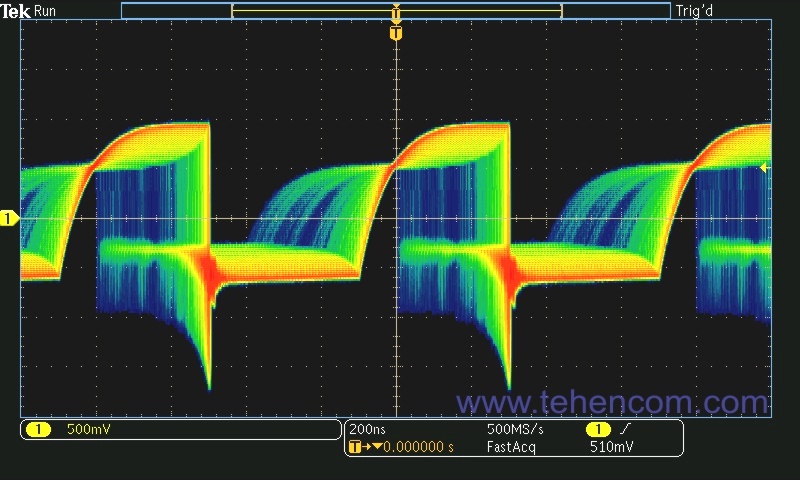
Decoding and analysis of serial protocols
Many electronic devices contain one or more serial data buses (Serial Buses). Such a serial bus is an interface for exchanging data using a specific protocol. A distinctive feature of serial buses is a small number of conductors necessary for its operation (usually 2, 3 or 4 pieces, sometimes more).
For example, using I2C and SPI serial interfaces, all kinds of peripheral microcircuits are connected to microcontrollers: sensors, ADC, DAC, interface modules, etc. To transmit sound in digital form I2S, LJ, RJ or TDM buses are used. In the car, all devices communicate using a single serial bus such as CAN or LIN. The MIL-STD-1553 serial communication interface is widely used in the aerospace industry.
Most modern oscilloscopes (with the appropriate options) allow you to decode serial bus signals on the fly, automatically looking for the necessary data or certain conditions. When a specified event is detected, such an oscilloscope can record and store all waveforms in memory for detailed analysis. This is a very powerful and useful feature.
Note that serial protocol decoding options may come standard (as with oscilloscopes from Pico Technology), and can be sold as additional options (like the oscilloscopes of the company Tektronix).
As an example, in this screenshot of a series oscilloscope MDO3000 shows the result of starting recording on a specific data packet transmitted over the I2C serial bus. The yellow waveform is the clock signal (CLK) of the I2C bus, and the blue one is its data (DATA). The oscilloscope has decoded the contents of the packet, including Start, Address, Read/Write, Data, and Stop.
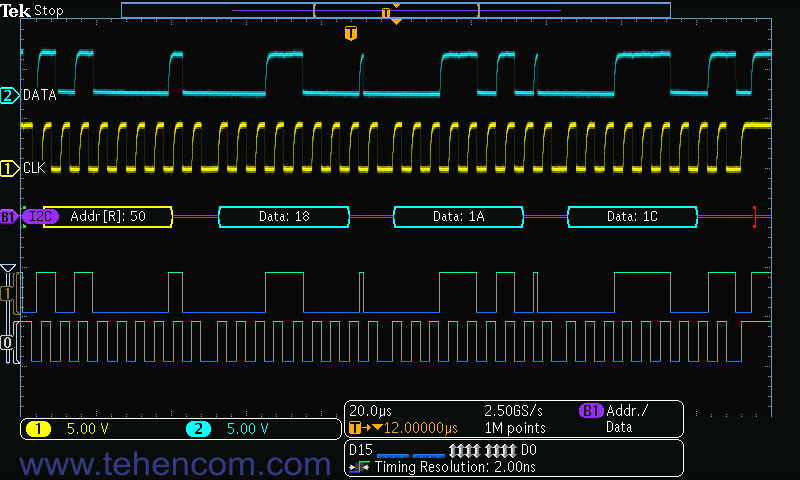
Logic Analyzer for parallel digital buses
Parallel Digital Buses are widely used for high-speed data exchange between microprocessors, memory, programmable logic arrays (PLA, FPGA) and fast ADC/DAC. Depending on the type, parallel buses can contain 8, 16, 32, or 64 digital signals. Most often, embedded systems use 8-channel and 16-channel buses, but 32- and 64-channel buses are also found, and in some developments, the number of digital channels can significantly exceed 64 pcs.
Since parallel digital buses are very common, good oscilloscope models can be equipped with a logic analyzer option with the ability to decode and analyze digital information. As a rule, this logic analyzer supports 16 digital signals and is physically implemented as a special digital probe that connects to a separate connector on the front panel of the oscilloscope. This is how this function is implemented in oscilloscopes of the series MDO3, MDO3000 and MDO4000C, in which a 16-channel logic analyzer is added using the P6316 or P6616 digital probe, and in the series PicoScope 6000E, where an 8 or 16 channel logic analyzer is added using TA369 digital probes.
As an example, this photo shows a Tektronix MDO34 oscilloscope (MDO3 series) with two analog probes (left) and a 16-channel P6316 digital probe (right). If you click on this photo, an enlarged image will open, where you can clearly see all the details of the probe and the device screen. Read more about the function of the 16-channel logic analyzer here.
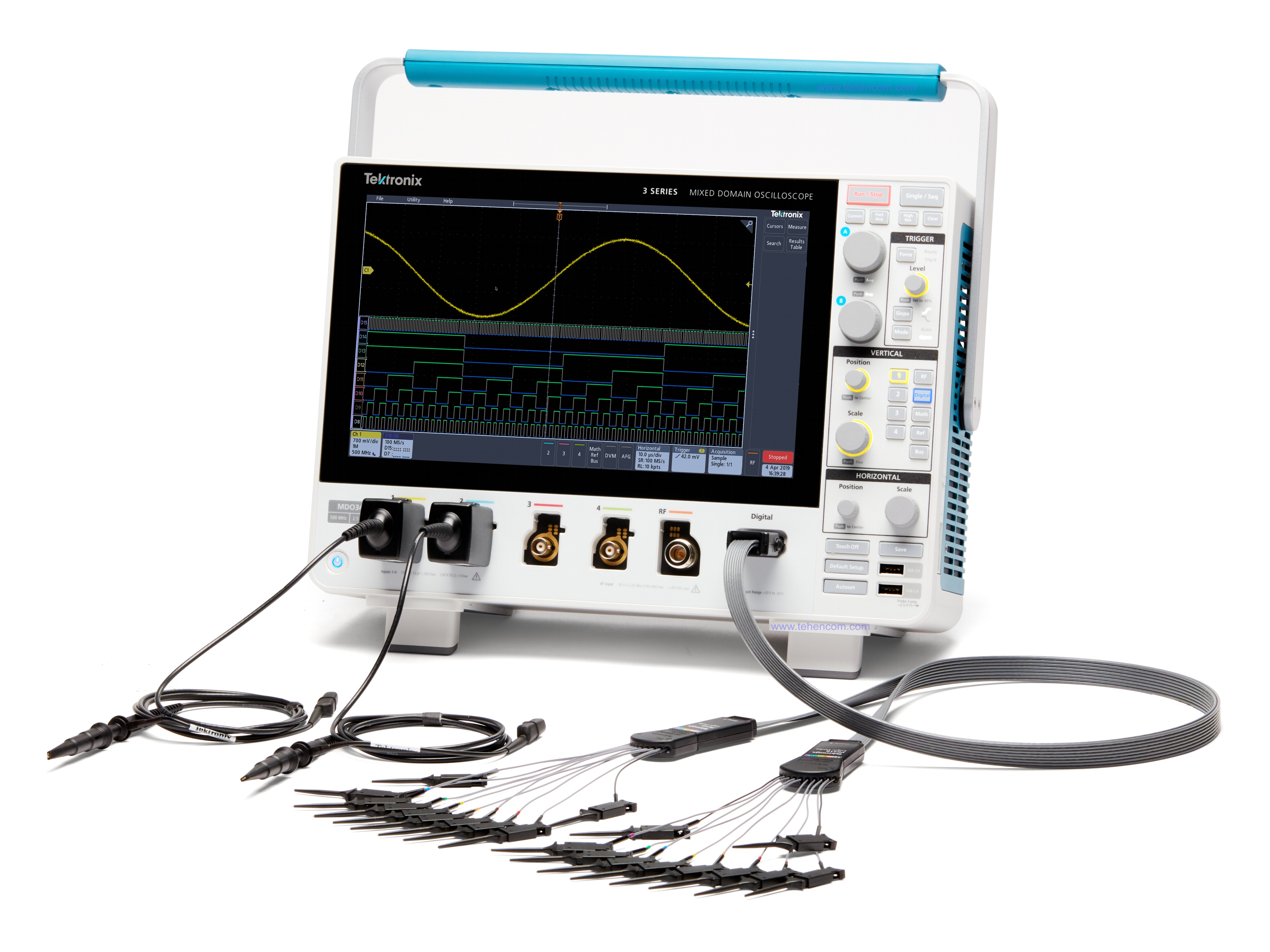
A completely different approach to the implementation of the built-in logic analyzer is used in new series of oscilloscopes MSO4, MSO5 and MSO6. Each channel of these oscilloscopes can operate as one analog channel or as eight digital channels. If you connect any standard probe (passive, active, current, etc.), then the channel works like an analog one, and if you connect a special TLP058 digital probe, the channel starts working like eight digital ones.
Thanks to this innovative technology called FlexChannel, you can add the required number of digital channels right in the process: up to 32 pieces for 4-channel oscilloscope models, up to 48 pieces for 6-channel models and up to 64 pieces for 8-channel oscilloscopes. This feature is very useful when developing and debugging complex multi-channel digital-analog systems. Read more about FlexChannel technology here. How it all works, see this video on the example of an eight-channel oscilloscope of the series Tektronix MSO5.
Measuring the frequency components of a signal
Almost all modern oscilloscopes have an FFT (Fast Fourier Transform) function that allows you to show the input signal in the frequency domain. The FFT function is only suitable for superficial signal analysis since it has three significant disadvantages: very low sensitivity (works with large amplitude signals and is not suitable for most RF signals), usually you can not watch the signal itself if FFT is enabled, the screen updates slowly.
Therefore, for a complete analysis of electronic circuits and equipment in the frequency domain, separate spectrum analyzers. Some series of oscilloscopes contain a full-fledged built-in spectrum analyzer, while the signal for analysis is fed to a separate input of the device. Examples of such oscilloscopes with a built-in spectrum analyzer: MDO3000, MDO4000C and new series MDO3.
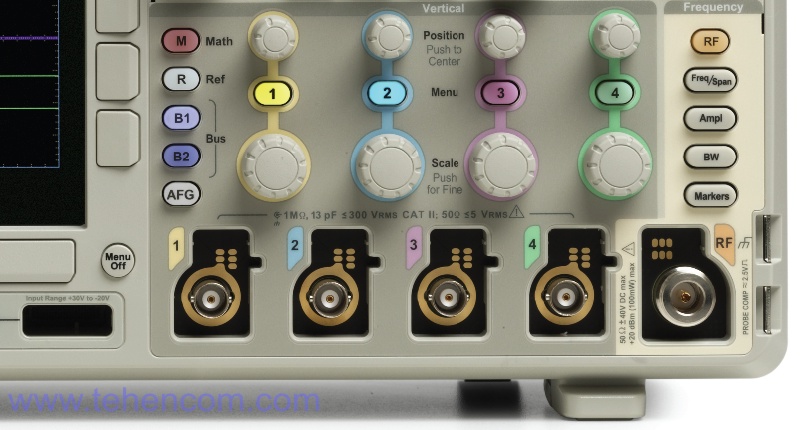
Probes and accessories
Even the most advanced devices cannot provide an accurate result if the data received by them has a large error. Probes combined with an oscilloscope form a single measurement system. The measurement error starts to accumulate from the probe tip. Therefore, it is important to choose the right probes to match your oscilloscope and device under test. High-quality and well-chosen probes minimally distort the signal under study and contribute to high measurement accuracy.
There are several basic types of probes. Each type is well suited for its kind of measurement:
- passive probes
- active probes
- differential probes
- high voltage probes
- current probes
- galvanically isolated probes
This photo shows typical members of each of the six probe categories. In addition to these main categories, there are also probes for special applications, such as measuring noise and ripple on power rails for electronic devices. A detailed guide to choosing probes (about 100 models of all types in total) is located below on this page in the section Additional Information.
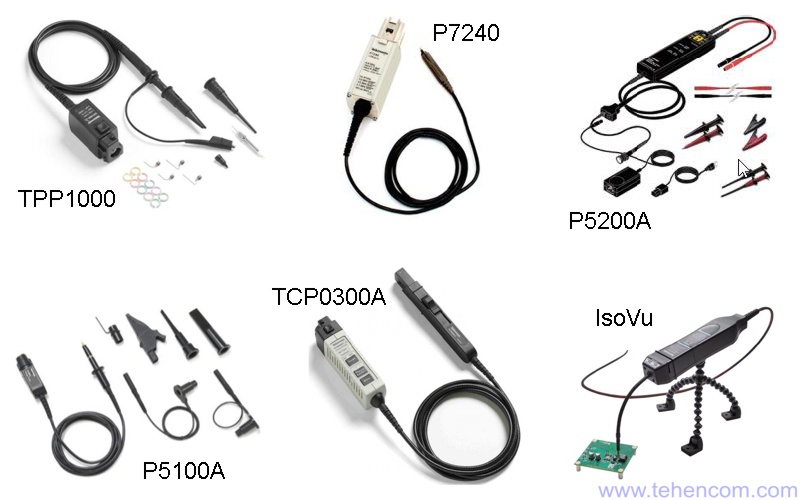
Typical oscilloscope applications
Now that we have dealt with the main selection criteria, we will consider typical oscilloscope applications and instrument models suitable for these tasks.
Basic oscilloscope for laboratory
For most typical tasks that arise when developing or repairing electronic equipment, the Tektronix MSO / DPO2000B series (100 - 200 MHz, 2 or 4 channels, $1,000 - $4,000) is excellent, which was created as the main oscilloscope capable of solving 90% of issues in up to 200 MHz:
For more complex applications or for a long-term purchase, choose the Tektronix MDO3 series (100 MHz - 1 GHz, 2 or 4 channels, $4,000 - $15,000), which supports a large number of expansion options, includes a built-in spectrum analyzer and allows you to expand if necessary. bandwidth with an activation code:
Development of multichannel analog-digital devices
For complex systems containing many different analog and digital signals, choose the Tektronix MSO5 Series (350 MHz - 2 GHz, 4, 6, or 8 analog channels, up to 64 digital channels, starting at $15,000):
or a series of professional USB oscilloscopes Pico Technology PicoScope 6000E (up to 500 MHz, up to 8 analog channels, up to 16 digital channels, from $5,000):
For simpler analog-to-digital systems, as well as for power conversion and transmission systems, the Tektronix MSO4 series (200 MHz - 1.5 GHz, 4 or 6 analog channels, up to 48 digital channels, from $ 8,000) is well suited:
For entry-level analog-to-digital systems, the best are: the Pico Technology PicoScope 3000D USB series (50 - 200 MHz, 2 or 4 analog channels + 16 digital, $600 - $2,500) and the Tektronix MSO / DPO2000B desktop series, which was already mentioned in this comparison (100 - 200 MHz, 2 or 4 analog channels + 16 digital, $1,000 - $4,000):
Professional oscilloscope for very demanding applications
When you need maximum analysis of analog and digital signals up to 1 GHz and simultaneous analysis of RF signals up to 6 GHz, choose the Tektronix MDO4000C Series (4 analog channels up to 1 GHz and 16 digital channels, spectrum analyzer up to 6 GHz, $8,000 - $20 000):
In the frequency range of several gigahertz, the Tektronix MSO6 series is optimal, which combines advanced signal analysis capabilities with low-noise input paths and accurate digitization of 12-bit ADCs (4 analog channels up to 8 GHz, up to 32 digital channels, from $20,000):
If the frequencies of the signals you need to work with are gigahertz and tens of gigahertz, then you need the Tektronix MSO / DPO70000 series (4 - 33 GHz, 4 channels, from $40,000):
Oscilloscope with isolated (independent) inputs for power and high voltages
When working with high voltage (for example, power grids), as well as when working with galvanically isolated equipment nodes (optocouplers, transformers, electrically isolated sensors and signal acquisition systems), you need to use an oscilloscope, in which each channel is independent and isolated from other channels and the network the power supply of the oscilloscope itself. A special series is offered for this task: Tektronix TPS2000B (100 - 200 MHz, 2 or 4 channels, $4,000 - $6,000):
The cheapest oscilloscope, but high-quality and functional
Three series are offered in the range up to $1,000:
1. Economy series in USB version: PicoScope 2000A и 2000B (10 – 100 MHz, 2 and 4 channels).
2. Economy series in a classic case: Tektronix TBS1000B (30 – 200 MHz, 2 channels).
3. Series for educational institutions: Tektronix TBS1000B-EDU (50 – 200 MHz, 2 channels).
Additional information on this topic
We deliberately did not overload this article with the technical details of the oscilloscope design and a detailed description of their options. You can read all this on the pages individual series of oscilloscopes. But for those who want to understand the issue as much as possible, we recommend that you familiarize yourself with this information:
12 criteria for choosing the best oscilloscope (in Russian) (30 pages; 7 MB)
Oscilloscope Basics Tutorial (in Russian) (60 pages; 2 MB)
Tektronix Oscilloscope Probe Selection Guide (23 pages; 4 MB)
DPO digital phosphor technology in oscilloscopes – principle of operation, application examples
Comparison and selection of 500 MHz oscilloscopes
To simplify the process of choosing a digital oscilloscope, you can use our experience and recommendations. We have over 20 years of practical supply experience and can immediately answer many questions about models, options, delivery times, prices and discounts. This will save your time and money. For this it's simple call us or write to us at E-mail and we will be happy to answer your questions.









